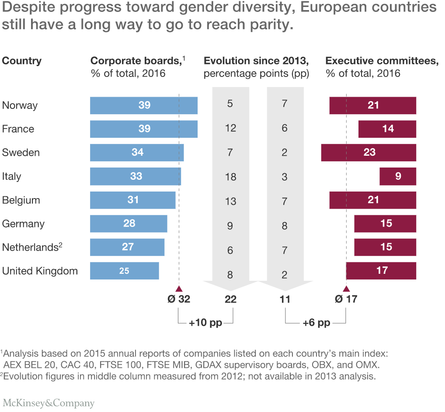|
Three efforts could kick-start progress to get more women in leadership positions. The case for gender diversity is compelling, but McKinsey research—including a new report, Women Matter 2016: Reinventing the workplace to unlock the potential of gender diversity—shows many companies are struggling to ensure women are represented fairly in top management. Progress toward parity remains slow. In Western Europe, only 17 percent of executive-committee members are women, and women comprise just 32 percent of members of corporate boards for companies listed in Western Europe’s major market indexes (exhibit). In the United States, the figures are 17 percent for executive committees and just under 19 percent for boards. Would you like to learn more about our Organization Practice?
European women work more part-time and more unpaid hours than men. Our new study found a correlation between the representation of women in leadership positions and women’s employment rate, as well as their hours of unpaid work. Increasing the number of women in top management requires tackling these two inequalities. Governments have a strong role to play in addressing this issue and creating the conditions for equal opportunities. But companies also have to do their part. To better understand what companies do, and what they could do further, in 2016, we surveyed 233 companies and 2,200 employees in nine European countries.1 Analysis showed that while the vast majority of companies have introduced measures to increase gender diversity at the top, many have yet to see significant results. Among our findings:
Previously, we outlined a comprehensive gender-diversity ecosystem that companies can put in place to increase women’s representation at each level of the organization. Building on this, our 2016 research shows that three game-changers distinguish best-in-class companies:
We believe it will take government and business-led interventions to create an environment that offers women better opportunities; enables them to train for and work in skilled, better-paying roles; reshapes social norms and attitudes; and supports work–life balance. To achieve this, companies will need to transform themselves by reevaluating their traditional performance models and by challenging the long-term viability of their prevailing leadership styles. About the author(s) Sandrine Devillard and Sandra Sancier-Sultan are senior partners in McKinsey’s Paris office, where Alix de Zelicourt is a consultant and Cecile Kossoff is the director of knowledge dissemination and communications.
3 Comments
5/10/2019 03:20:17 pm
The workplace is really important, especially if you want to be productive. There are certain workplaces that can hinder the productivity of some of its employees. There are a lot of elements that constitutes a bad work place. First of all, a workplace that features small spaces can be considered bad. The heat and lack of room can really make employees relatively unhappy. Another thing that makes a workplace uninhabitable, is the very people inside them. Obnoxious and toxic people can really destroy a work space.
Reply
5/24/2019 07:10:10 am
Workplace diversity is something that is important within the company as well as outside. A renowned company basically known for its ethics. And I don't think it could be possible without diversity in the duty station. For that reason, the significance of diversity in the workplace can never be overstated. It is essential to have a diverse workforce in an organization. Because only a diverse team can bring creative introspection and new ways of thinking to the table.
Reply
Leave a Reply. |
Archives
April 2019
Categories
All
|


 RSS Feed
RSS Feed